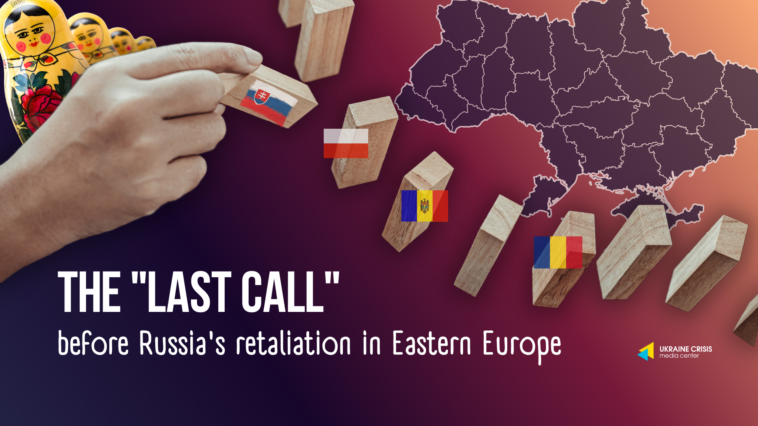Marianna Prysiazhniuk, UCMC expert
The pro-Russian SMER-SD (Course – Social Democracy) party of former Prime Minister Robert Fico, who openly supported Russia, while justifying Russia’s military aggression against Ukraine, won parliamentary elections in Slovakia. The incident sparked significant concern in Ukraine, the EU, and Slovakia. The rise to power of a pro-Russian party is a tactical victory for Russia, but 2024 may mark the end of a new round of Russian political expansion in the EU.
Eastern Europe’s pro-Russian trend
Since 2020, the state of affairs with Russian influence in Slovakia has been crucial. This was even mentioned in a police report in Slovakia. After Russia’s full-fledged aggression began, Slovakia continued to provide military assistance to Ukraine and find Ukrainian refugees a home. However, the impact of Russian propaganda is now evident: 69% of Slovaks believe that arms supplies to Ukraine are “provoking” Russia, not to mention the recent parliamentary elections results.
On this wave, former Prime Minister Robert Fico’s SMER-SD (Course – Social Democracy) political party received 23% of the vote, while the traditionally “pro-Ukrainian party” (Progressive Slovakia) and the moderate center-leftists (Voice) received 18% and 15%, respectively. Thus, the decisive vote in the formation of the future coalition will belong to Fico’s party, so the real fight is still yet to come.
The same goes for Poland. Parliamentary elections in Poland will be held on October 15. Despite the fact that pro-European forces–the ruling Law and Justice party and the opposition Civic Platform of former European Council President Donald Tusk–dominate the Polish political landscape, the pro-Russian Confederation of Freedom and Independence has risen to third place. This means that the pro-Russian project in Poland will have an impact on the formation of the coalition and, as a result, the government.
Between 13 and 15% of voters are prepared to vote for the Confederation, a figure that has more than doubled since the Confederation’s election to the Polish Sejm in 2019.
The Republics of Moldova and Romania are the next neighboring countries where elections are unfolding. And, yes, these two countries should be considered an inseparable unity, not only because they share a number of common regional factors, but also because the content of Russian propaganda in this context is to oppose these countries and thus create tension and hostility.
Thus, in Moldova, which nevertheless remains conditionally pro-European, despite significant support for pro-Russian forces within the country, and with de facto two pro-Russian regions (occupied Transnistria and the autonomous region of Gagauzia), local elections are scheduled for November 5, including a “battle for the capital.” The features of the presidential campaign in 2024, as well as Russia’s strategy for Moldova, will be determined by the local campaign. This is not because Russian special forces don’t know how to operate, but because the situation in Moldova to counter Russian expansion could be classed as ‘proactive’.
Not so long ago, Moldova declared the pro-Russian party Shor unconstitutional, and its leader, Ilan Shor, who is currently hiding in Israel, was placed on sanctions lists in the United States and the United Kingdom on charges of attempting to destabilize Moldova through cooperation with Russian special services. This significantly weakened Russia’s position in this area, allowing it to at least gain time until newly formed political projects (which have already appeared!) formed an image and began to participate fully in the republic’s political life.
Finally, in 2024, Romania will hold simultaneous presidential, parliamentary, and local elections. The room for maneuver in traditionally anti-Russian Romania has expanded significantly since the start of full-scale aggression. According to preliminary estimates from Romanian media, the pro-Russian party AUR, which came to power on the basis of national rhetoric and the idea of “unionism,” or the unification of Romania and Moldova, with less than 10% support, has already doubled its supporters.
Meanwhile, since the start of Russia’s full-scale aggression against Ukraine, the main party actors have openly consulted with the Russian Embassy in Romania, broadcasting outright propaganda and speculating with skepticism adapted to Romanian society’s information realities. The notorious Senator Diana Shoshoaka’s initiative to annex the “primordially Romanian lands” within Ukraine to Romania is a case in point.
“Arc of instability”
A study of political trends in neighboring countries reveals that Russia is more concerned with creating a conditional “zone of instability” around Ukraine than with undermining bilateral relations. A scenario like this would make it much more difficult to resolve issues that require support and consolidation with neighboring countries, such as agricultural product transit, logistics routes for arms supplies, and other forms of political mediation involving “pro-Ukrainian” states. It’s no surprise that these issues are prominent in the political discourse of pro-Russian politicians.
It is worth noting that for many years, Russia has been mirroring the West by accusing it of creating an “arc of instability” around it. Therefore, this is an indirect confirmation that this approach is a technology, and sensitive topics with the potential for interstate strife are a tactical element of broader political expansion.
Thus, the scenarios of political processes in Ukraine-friendly states can have a negative impact at multiple levels:
- Bilateral relations with Ukraine (though this option is not the worst in the long run due to the long history of diplomatic resolution of such “disputes”);
- Changes in the Eastern European political landscape, which may have a negative impact on Ukraine’s so-called “European rear” in terms of logistics and mediation;
- Euroscepticism as a pan-European trend in the context of European elections in 2024.

